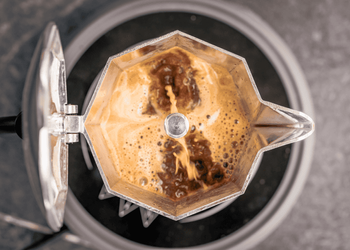
Aeropress vs Moka Pot: Know The Exact Difference

If you're a coffee enthusiast, you know the importance of the method you choose to brew your coffee. In the world of coffee brewing, the Aeropress and Moka Pot are two different and popular methods that are appreciated by most coffee lovers.
But how do they differ? Don't worry. Today in this guide, I will share with you the differences between Aeropress and moka pot, their similarities, and every basic detail about these two coffee-making marvels, and help you decide your ideal match.
Aeropress: Overview
What is Aeropress?
Invented by Alan Adler in 2005, Aeropress is a unique and innovative coffee brewing device designed for brewing a clean and flavorful cup of coffee. This compact and portable device is popular among coffee enthusiasts for its simplicity and the ability to produce delectable coffee.
The Aeropress consists of two cylindrical chambers which are mostly made of durable plastic. Here the larger chamber works as a brewing chamber, while the smaller one works as a plunger.
To brew delectable coffee with an Aeropress, you begin by placing a paper or metal filter at the bottom of the brewing chamber. Then, you add a specific amount of coarsely ground coffee and hot water.
Once the mixture is stirred well, you attach the plunger and gently press it down, forcing the brewed coffee through the filter and into your cup. Aeropress is versatile as it allows you to adjust various brewing parameters, like coffee grind size, water temperature, and brewing time, to customize the taste of your coffee.
What makes it outstanding is its high portability. It is an excellent choice for travelers or those who want a reliable way to brew coffee at work or while camping.
Advantages of using an Aeropress
1) Delectable coffee
The Aeropress is famed for producing a clean and sediment-free cup of coffee. Its unique brewing process yields amazing coffee by rich extraction of coffee oils and aromas, resulting in a delightful coffee experience.
2) Quick brewing
Compared to other brewing methods, the Aeropress is handy and efficient. It can brew up a delicious cup of coffee in just a matter of minutes, making it a favorite among coffee lovers who crave a quick caffeine fix on busy mornings.
3) Versatile and customizable
Aeropress allows you complete control over various brewing parameters, like coffee grind size, water temperature, and brewing time to craft a customized cup based on your preference.
4) Ease of cleaning
Cleaning Aeropress is straightforward. As it uses disposable filters, you can simply remove the filter and rinse the components, and you're done. This makes it a handy choice for those who want a hassle-free cleanup routine.
5) Portability
When it comes to portability, Aeropress tops the list with its compact design and lightweight. It can easily fit anywhere, so you can have a flavorful cup anytime, anywhere.
6) Durable and low maintenance
Made of sturdy plastic, the Aeropress is designed to stand the test of time. It's resistant to wear and tear, and its simple design means fewer parts are prone to breakage or malfunction, resulting in minimal maintenance needs.
7) Consistency
Aeropress's innovative design helps you brew consistent coffee. This reliability is appreciated by most baristas and home brewers who crave a reliable and consistent coffee-making process.
8) Affordable
Aeropress is quite affordable. For a fantastic cup of coffee, you don't need expensive equipment or accessories. Just an aeropress is enough.
Disadvantages of Aeropress
1) Single-serving capacity
The Aeropress brews 1-2 cups in a single cycle so it is ideal for solo sippers. But if you need to brew large batches, you'll have to repeat the process multiple times.
2) Requires manual effort
Aeropress requires manual plunging, which means you need to make physical effort. So It might be challenging for those with wrist or arm issues.
3) Paper filter dependency
While paper filters are available in general with the Aeropress, most coffee lovers opt for reusable metal filters for sustainability. Metal filters are sustainable but need proper maintenance for a flavorful taste.
4) Precision required
To achieve the best results with an Aeropress, you need to be precise with factors like water temperature, grind size, and brewing time. Beginners may find it challenging to master these variables.
5) Not ideal for espresso
While the Aeropress can produce a concentrated coffee similar to espresso, it's not a true espresso machine. Espresso enthusiasts may not find it a suitable replacement.
6) Portability with accessories
While the Aeropress itself is highly portable, carrying additional accessories like filters and a grinder can take up extra space.
Moka Pot: Overview
What is a Moka pot?
In 1933, Italian engineer Alfonso Bialetti introduced the Moka pot, a classic coffee brewing device also known as a stovetop espresso maker.
It gained fame for its ability to produce a strong and robust coffee that somewhat resembles espresso, although it's not quite the same.
The Moka pot working is simple and consists of three primary components. The bottom, upper, and middle chambers. The bottom chamber here is filled with water, and the Moka pot is placed on a stovetop or another heat source.
It features a safety valve to release excess pressure. In the middle chamber, a filter basket holds the ground coffee. As the water in the bottom chamber heats up, it creates steam, which forces its way through the coffee grounds, extracting their flavors and aromas to yield a flavorful cup of coffee.
Once the brewing process is complete, the freshly brewed coffee is collected into the upper chamber for serving.
The Moka pot is beloved for its simplicity and robust construction. It can be found in almost every Italian household and is cherished worldwide for brewing strong and concentrated coffee.
Many people even refer to the coffee it produces as "Moka coffee."
Advantages of using a Moka pot
1) Budget-friendly
Moka pots are an affordable way to savor espresso-like coffee without breaking the bank.
2) Durable
Crafted from robust materials such as stainless steel or aluminum, Moka pots can last longer, with the proper care and maintenance.
3) Versatility
One of the Moka pot's standout features is its availability in various sizes, typically ranging from one to twelve cups. This versatility allows coffee enthusiasts to brew the perfect amount, whether they're enjoying a single cup or serving a larger group.
4) Ease of use
Moka pot is relatively simple to use. You don't need any barista skills or complex machinery. Just add some water, add coffee grounds, and put it on a heat source.
5) Portable
Moka pots are compact and quite portable, which makes them suitable for travel or outdoor use. All you require is a heat source, and you can cherish your favorite coffee anywhere.
6) Minimal maintenance
You don't have to make much effort to maintain a moka pot. It has few parts so regular cleaning and maintenance is handy.
Disadvantages of Moka pot
1) Maintenance required
Though moka pots are durable, they need regular cleaning and maintenance which is time-consuming.
2) Learning curve
Using a Moka pot can be a bit challenging for beginners. Achieving the right brewing balance, including grind size, water temperature, and pressure requires some practice.
3) Brewing time
Compared to some other coffee brewing methods, Moka pots may take a slightly longer brewing time, which might not be suitable for those seeking a quick caffeine fix.
4) No brewing control
Moka pots don't provide control over variables like pressure and temperature, which may affect the quality of the brew.
5) Limited capacity
Moka pots come in various sizes, but they can generally hold a smaller capacity compared to other coffee makers. This limitation may not be ideal for serving multiple cups of coffee at once.
6) Not for all coffee types
While Moka pots produce strong and concentrated coffee, they may not be suitable for making specialty coffee drinks that require specific brewing methods.
Aeropress vs Moka Pot: Quick Comparison
1) Material
Aeropress is mainly made of durable plastic so it is lightweight and portable which makes it travel-friendly while Moka pot is specifically made of stainless steel or aluminum which makes it perfect to stand the test of time. So if you want a travel-friendly option go for Aeropress Moka Pot is reliable.
2) Brewing capacity
If you want just a single or small batch of coffee go for Aeropress while if you want to serve large cups or prepare larger capacities for multiple servings choose Moka Pot.
3) Brewing method
Aeropress uses air pressure and a paper or metal filter for immersion and extraction while the moka pot operates on the stovetop, using steam pressure to force water through coffee grounds.
4) Durability
Aeropress is made of plastic material, which makes it less prone to damage, but it still can't match metal alternatives, while Moka pot is made of stainless steel or aluminum construction, providing excellent durability and being capable of withstanding years of use.
5) Types of coffee needed
Aeropress can easily accommodate various coffee grinds, which gives you flexibility in coffee selection, while Moka pot needs a coarser coffee grind specifically suited for stovetop percolation.
6) Price
Aeropress is comparatively more affordable, which makes it budget-friendly, while Moka Pot is a bit expensive due to its metal construction but still relatively affordable.
7) Ease of cleaning
Aeropress has fewer components, which makes it easy to disassemble and clean. Cleaning a moka pot requires proper disassembly, which is time-consuming.
8) Brewing control
With Aeropress, you get complete control over variables like grind size, water temperature, and brewing time, with which you can customize your cup, while Moka Pot offers control but is not as precise as Aeropress, with pressure and stovetop temperature being the main factors.
9) Flavor profile
Aeropress enables you to experiment with flavor profile adjustments suitable for various coffee preferences, while Moka Pot generally produces a rich, bold coffee with a flavor profile somewhat resembling espresso.
10) Portability
Aeropress is ideal for travel and on-the-go coffee brewing as it is extremely portable and compact, while Moka Pot is compact but less convenient for travel as it needs a heat source.
11) Ease of use
Aeropress is user-friendly with straightforward steps, which makes it handy for beginners, while moka pots have a steeper learning curve, which makes it challenging to achieve the desired brewing balance.
12) Brewing Time
Aeropress is perfect for those seeking a swift caffeine fix, while Moka Pot takes a slightly longer brewing time.
13) Beginner-friendly
Aeropress is marked for its simplicity and user-friendliness, so it is a great choice for beginners, while Moka pot requires some practice and familiarity with stove-top brewing, which makes it less beginner-friendly.
Moka pot or Aeropress: Which is better for you?
In the end, the choice between the Aeropress and the Moka Pot depends on personal preferences.
If you are looking for precision, quick brewing, and portability, the Aeropress is the ideal choice but if you savor tradition, and durability, and want a rich coffee experience, the Moka Pot is the better companion.
Wrapping up
In the Aeropress vs. Moka Pot showdown, both coffee makers have their different advantages and limitations.
Generally, I go for the Aeropress when I am traveling or want to make a single cup while during social gatherings moka pot is the savior. Aeropress is also handy in cleaning so it is a quick fix when I am running late. Check out different parameters and select the one that ticks the most.

I am a coffee aficionado based in Seattle. I have devoted my passion and expertise to perfecting the art of home coffee brewing. I became known for my exquisite pour-over and espresso creations. I source coffee beans from local roasters and explores ...


